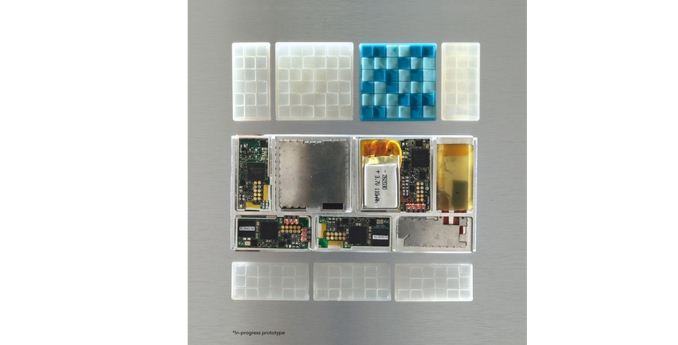Modular Smartphone Project Ara from Google to Start Development Conferences
by Ian Cutress on February 26, 2014 6:49 PM EST- Posted in
- Smartphones
- Mobile
- Project Ara
- Conferences

Joshua talked about Project Ara (from Motorola at the time) back in October as a campaign that focused on attracting OEM interest into a modular smartphone design. The results of that campaign take the next step forward as Google announces the first set of developer conferences for a modular device.
Headed under the Advanced Technology and Projects (ATAP) division, the platform is meant to be a single hub onto which the user can place their own hardware. This means CPUs, cameras, sensors, screens, baseband, modems, connectivity, storage – the whole gamut. The issue with such a device compounds the effects of going from a managed ecosystem (Apple and several hardware combinations) to a free ecosystem (Android and every hardware combination). Project Ara takes this complexity one stage further, and there has to be a fundamental software base to solve this. Hence ATAP is going to be doing three developers’ conferences in 2014, starting on April 15-16 at the Computer History Museum in Mountain View, California.
Aside from those attending in person, the event will be live webcast with question and answer sessions built into the programme. Due to the early stage of Project Ara, the initial conference is all about the modular system itself, building a device and getting it to work. Coinciding with the first conference, an alpha version of the Module Developers’ Kit should be available.
The other two conferences for 2014 are yet to be announced. Further info on the conference is found at the website projectara.com, to be updated over the next few weeks with more details.
To quote the website:
We plan a series of three Ara Developers’ Conferences throughout 2014. The first of these, scheduled for April 15-16, will focus on the alpha release of the Ara Module Developers’ Kit (MDK). The MDK is a free and open platform specification and reference implementation that contains everything you need to develop an Ara module. We expect that the MDK will be released online in early April.
The Developers’ Conference will consist of a detailed walk-through of existing and planned features of the Ara platform, a briefing and community feedback sessions on the alpha MDK, and an announcement of a series of prize challenges for module developers. The complete Developers’ Conference agenda will be out in the next few weeks.
This first version of the MDK relies on a prototype implementation of the Ara on-device network using the MIPI UniPro protocol implemented on FPGA and running over an LVDS physical layer. Subsequent versions will soon be built around a much more efficient and higher performance ASIC implementation of UniPro, running over a capacitive M-PHY physical layer.
The Developers’ Conference, as the name suggests, is a forum targeted at developers so priority for on-site attendance will reflect this. For others--non-developers and Ara enthusiasts--we welcome you to join us via the live webstream. That said, we invite developers of all shapes and sizes: from major OEMs to innovative component suppliers to startups and new entrants into the mobile space.











28 Comments
View All Comments
fteoath64 - Thursday, February 27, 2014 - link
Believe it or not a laptop has far more constraints due to weight and size of components, making the chassis/casing design very challenging and expensive. It is already a "no starter". In the phone scenario, due to lightweight parts and small size, a thin and strong aluminium backplate even with slots covered by plastic covers (ie thin and strong coloured) would be cheap or easy to make.Defining the connector standard is going to take some effort due to number of pins needed unless some sort of system-serial-bus standard has been defined for inter-connecting modules. First order would be to define what a module is and its interfaces. Then the connectors needed, either one sided, two sided or three sided. That is on one plane. You have to consider stacking modules and the last module being the screen would stack on top!. Some modules would have buttons/slots/plugs and need to be on specific sides of the mainboard.
Yes, it is all doable but will end up with a thicker phone with varying functionality. There would be a need to have silver-coated shielding tape to cover the necessary area before the final module being either screen or back plate slides into place. Then we shall have people putting this on a rubberised case to make it even bulkier!. Would we end up with a design similar to the older Motorola brick phone where the owner has 3 MicroSd slots, 2 SDcard slots, 6 GB RAM and a tiny screen but a huge 20MP dualcam module doing 4k on 2 streams while LTE 150mbps to a server!!!. His phone rig!.
nerd1 - Friday, February 28, 2014 - link
I wonder exactly WHAT people want from modular phone.Bunch of memory slots? We already have 128gb micro sd card, and there are bunch of wifi-enabled portable HDDs as well. 6GB ram? I bet that will be a standard when 64bit OSs are ready (Many phones are already equipped with 3GB of ram). 20MP camera module? Sony and nokia already have one and sammy will catch up soon.
Whatever you want from modular phone, it will be materialized AT THE SAME TIME from major brands anyway.
1Angelreloaded - Friday, February 28, 2014 - link
ok where to begin, unfortunately you are highly wrong on this one, the Clevo is a great example of why modular laptops work well, but not exactly within the truly modular idea frame, the modular components are in the different vendors that we see selling them in different fashions, because of the way Laptops are setup Modular at this point took a huge leap forward when most of the manufacturers stopped soldering down the heatpipes to the motherboard and allowed for easy CPU exchanges, the problem isn't the fact laptops aren't modular the fact is no one makes the parts for reasonable consumption and competitive prices.ABR - Thursday, February 27, 2014 - link
I assume they've considered and solved most of the software-level integration problems mentioned. Modules all come with factory firmware capable of bootstrapping (into) the device network, there's infrastructure and support for OTA upgrades, etc.. The part I'm having trouble with is the "why". I think this is something more about how phones are manufactured, rather than being directed at home tinkerers. Although the componentization of PCs did allow people to build them at home, the real story was the explosion of manufacturers and the resulting implosion of price once it became a game of Lego bricks. Phones can already be pretty low-priced, but that's only because massive volumes at the top tier manufacturers absorb the firmware development and hardware integration costs. This type of move would lower that bar substantially.SleepyFE - Wednesday, February 26, 2014 - link
It's gonna be interesting to follow progress on this. We'll see how far they get, but i'm afraid it won't enter the market.kpb321 - Thursday, February 27, 2014 - link
There is an inherent trade off to trying to do a modular phone. Your modular phone will end up either having worse battery life or being physically larger. Being modular requires extra space to surround the module, the "frame" to connect it all to and route things around, etc. This means less space for a battery or a bigger device.On top of that I don't see how you could ever avoid the fact that high speed buses that have to travel further and work through some sort of connector are going to require higher power than the equivalent bus on a PCB.
Not to mention the difficulty of properly optimizing everything so that things things can properly power down to their lowest power modes as much as possible.
Lonyo - Thursday, February 27, 2014 - link
That was one of the issues with x86 tablets, per an AT article. Intel's power use was high because everything wasn't fully optimised, but hardware + software + drivers all need to work together to optimise power use. A lot more difficult to get when you increase flexibility in hardware configurations.http://www.anandtech.com/show/6355/intels-haswell-...
nerd1 - Thursday, February 27, 2014 - link
This is downright silly. Current flagship phones already have best of everything, so there is absolutely no need for customization at all. Also they are heavily tested and customized - modular version will be way heavier, way less reliable, way costly.Then why do we need modular phone at all? We don't even have any 'modular' ultrabooks.
lada - Thursday, February 27, 2014 - link
Best camera? No, they have tiny ones. Best HW keyboards? No, not even a few buttons. External storage - eSATA ports? No. There's plenty of hardware that COULD interface to a mobile, if there was an interface. For specialised use, the smartphone can work as a voltmeter, wired ethernet tester, an oscilloscope, whatever - just the proper interface is needed. What about connecting a terabyte sata SSD to a phone to record something? What about enthusiast hi-fi audio sampling, external mics? What smartphone can do this?The trend is commoditisation, and for volume manufacturers that means lowering the bar, dropping rare features just to be able to sell it in a mass market.
Does any current smartphone a cap over the camera? Hardware mutable MIC?
I'm looking forward to SDR - software defined radio on a smartphone. That could make a (otherwise versatile) platform support any wireless protocol out there just with a program/firmware/FPGA update. Imagine the phone being able to decode FM radio, transmit it, support Global Maritime Distress and Safety System, HAM radio, software GPS, anything wireless, even wired. I2C debugger?
I'm hoping this would be a mobile version of a Raspberry Pi - extensible to just about any peripheral. Personally, I'd like to see those Nokia's 44Mpixel CCDs supported. This if for geeks.
p1esk - Thursday, February 27, 2014 - link
I think for what you're describing you would be better off just building everything yourself.